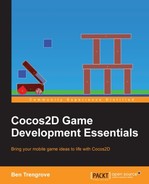Book Description
Bring your mobile game ideas to life with Cocos2D
In Detail
Focusing on the multiplatform nature of Cocos2D, this fast, fun, and helpful guide provides you with the best practices and sharpest techniques to turn your ideas into reality.
Beginning with the basics to give you a solid foundation of knowledge, such as how to display sprites on screen and organizing your game into different scenes, you will then discover how to use Cocos2D's in-built graphics editor, SpriteBuilder, to lay out your scenes, design animations, and configure complex physics interactions. You will also find out how to make your game interactive, as the book explores how to accept input touches and the accelerator.
The book is tailored to new users and also those who are upgrading from the old version.
What You Will Learn
- Use sprites and nodes to create scenes to form the foundation of your game
- Discover how SpriteBuilder and its graphical tools can be used to develop your game and increase its complexity
- Design professional, impressive, and fun-filled animations
- Create an impressive user interface for an engaging gaming experience
- Explore and use physics engines for attractive gameplay and use them to add a professional finish to your game
- Add physics to your game for a more realistic experience
- Accept user input through a variety of methods including touch and accelerometer
Downloading the example code for this book. You can download the example code files for all Packt books you have purchased from your account at http://www.PacktPub.com. If you purchased this book elsewhere, you can visit http://www.PacktPub.com/support and register to have the files e-mailed directly to you.
Table of Contents
- Cocos2D Game Development Essentials
- Table of Contents
- Cocos2D Game Development Essentials
- Credits
- About the Author
- About the Reviewers
- www.PacktPub.com
- Preface
- 1. Getting Started with Cocos2d
- 2. Nodes, Sprites, and Scenes
- 3. SpriteBuilder
- 4. Animation with SpriteBuilder
- 5. User Interaction and Interface
- 6. Physics Engines
- Index
